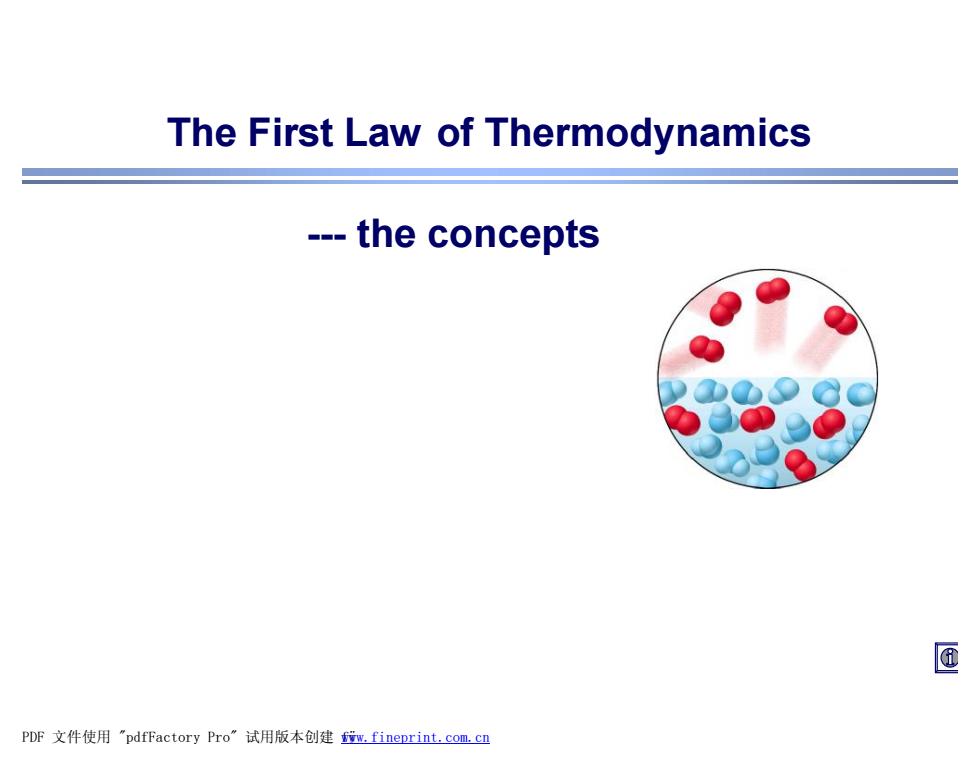
The First Law of Thermodynamics --the concepts @ PDF文件使用"pdfFactory Pro”试用版本创建m,fineprint..com,cn
The First Law of Thermodynamics --- the concepts PDF 文件使用 "pdfFactory Pro" 试用版本创建 f www.fineprint.com.cn ÿ
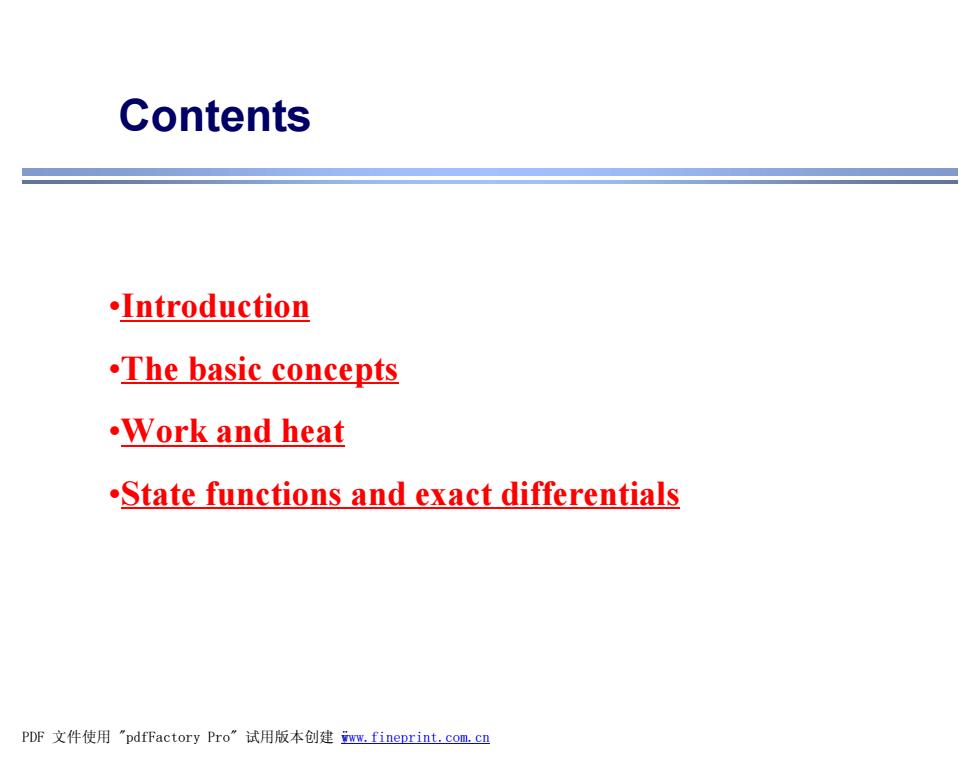
Contents .Introduction .The basic concepts .Work and heat State functions and exact differentials PDF文件使用"pdfFactory Pro”试用版本创建m,fineprint.com,cn
Contents •Introduction •The basic concepts •Work and heat •State functions and exact differentials PDF 文件使用 "pdfFactory Pro" 试用版本创建 ÿwww.fineprint.com.cn
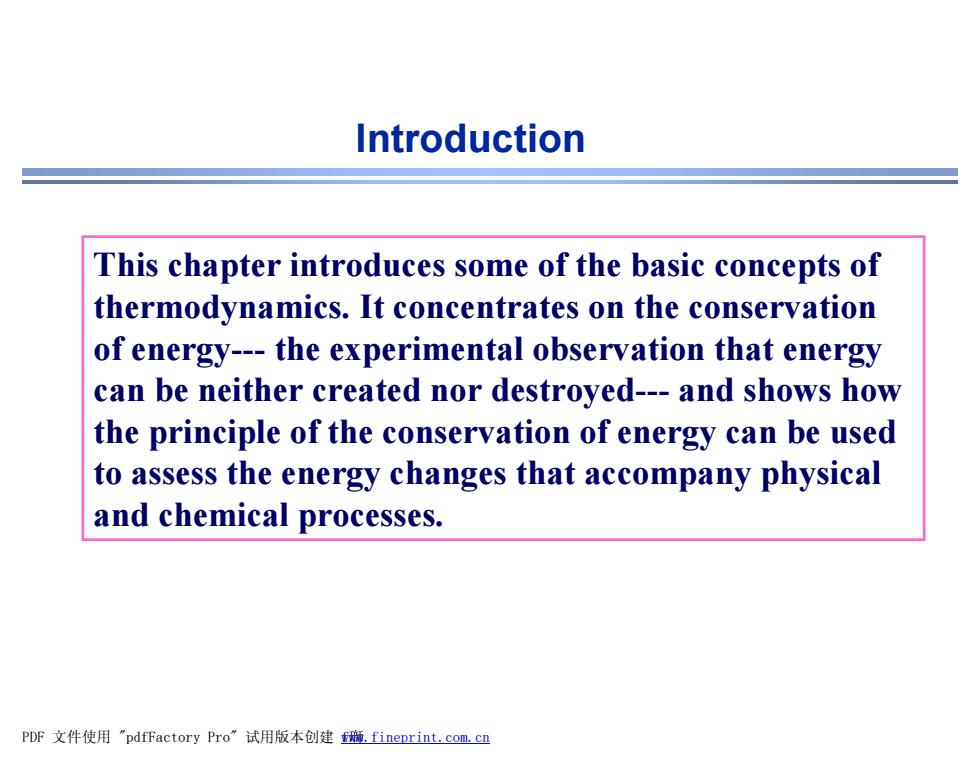
Introduction This chapter introduces some of the basic concepts of thermodynamics.It concentrates on the conservation of energy---the experimental observation that energy can be neither created nor destroyed---and shows how the principle of the conservation of energy can be used to assess the energy changes that accompany physical and chemical processes. PDF文件使用"pdfFactory Pro”试用版本创建题,fineprint.com,c里
Introduction This chapter introduces some of the basic concepts of thermodynamics. It concentrates on the conservation of energy--- the experimental observation that energy can be neither created nor destroyed--- and shows how the principle of the conservation of energy can be used to assess the energy changes that accompany physical and chemical processes. PDF 文件使用 "pdfFactory Pro" 试用版本创建 fwww.fineprint.com.cn 瑡
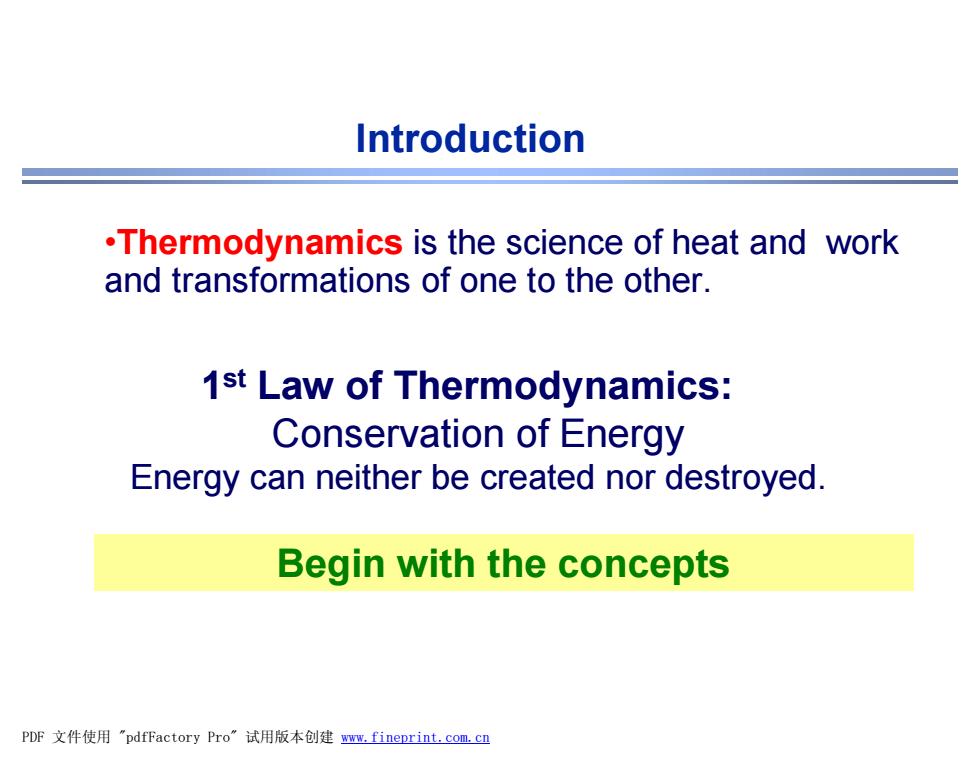
Introduction .Thermodynamics is the science of heat and work and transformations of one to the other. 1st Law of Thermodynamics: Conservation of Energy Energy can neither be created nor destroyed. Begin with the concepts PDF文件使用"pdfFactory Pro”试用版本创建m,fineprint.com,cn
Introduction •Thermodynamics is the science of heat and work and transformations of one to the other. 1 st Law of Thermodynamics: Conservation of Energy Energy can neither be created nor destroyed. Begin with the concepts PDF 文件使用 "pdfFactory Pro" 试用版本创建 www.fineprint.com.cn

System and Surroundings System This is the part in which we haveaspecial interest. Surroundings 2 They are the rest of the universe,and where we make observations. The universe the system the surroundings PDF文件使用"pdfFactory Pro”试用版本创建mm,fineprint.com,cn
System and Surroundings System This is the part in which we have a special interest. Surroundings They are the rest of the universe, and where we make observations. The universe - the system + the surroundings PDF 文件使用 "pdfFactory Pro" 试用版本创建 3www.fineprint.com.cn
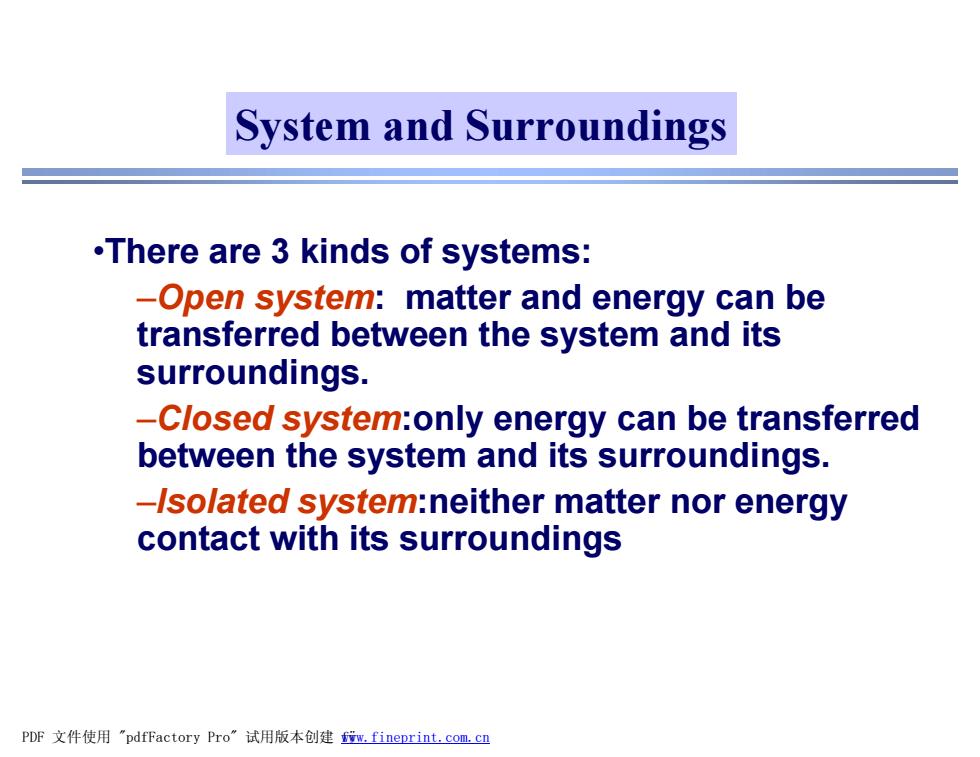
System and Surroundings .There are 3 kinds of systems: -Open system:matter and energy can be transferred between the system and its surroundings. -Closed system:only energy can be transferred between the system and its surroundings. -/solated system:neither matter nor energy contact with its surroundings PDF文件使用"pdfFactory Pro”试用版本创建m,fineprint.com,cn
•There are 3 kinds of systems: –Open system: matter and energy can be transferred between the system and its surroundings. –Closed system:only energy can be transferred between the system and its surroundings. –Isolated system:neither matter nor energy contact with its surroundings System and Surroundings PDF 文件使用 "pdfFactory Pro" 试用版本创建 f www.fineprint.com.cn ÿ
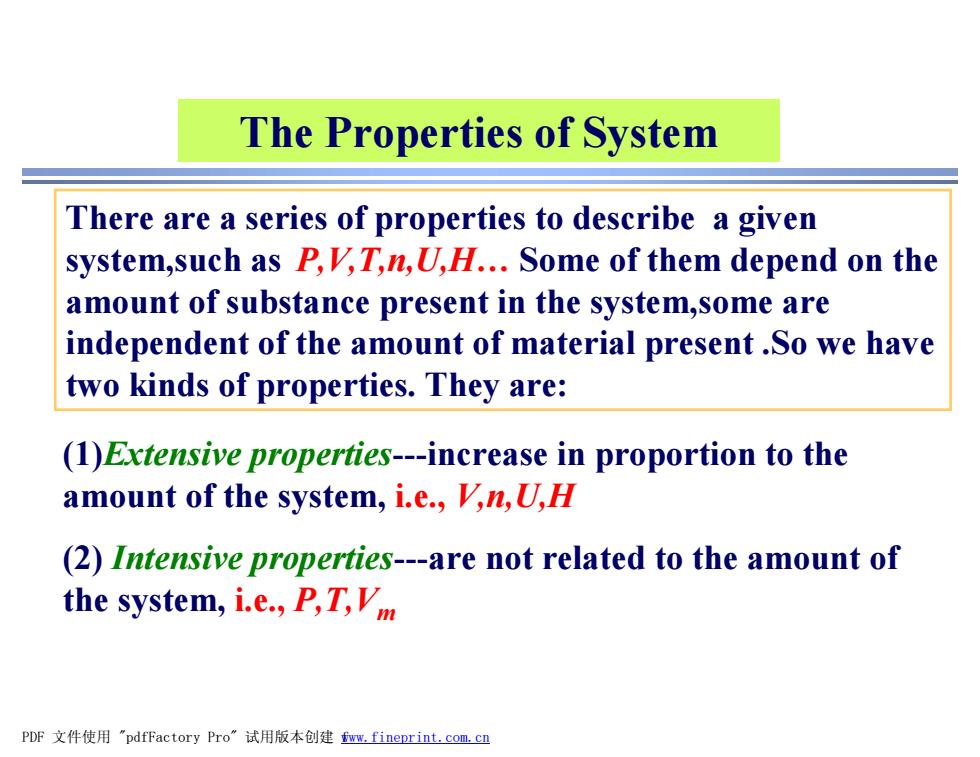
The Properties of System There are a series of properties to describe a given system,such as P,V,T,n,U,H...Some of them depend on the amount of substance present in the system,some are independent of the amount of material present .So we have two kinds of properties.They are: (1)Extensive properties---increase in proportion to the amount of the system,i.e.,V,n,U,H (2)Intensive properties---are not related to the amount of the system,i.e.,P,T,Vm PDF文件使用"pdfFactory Pro”试用版本创建fmm,fineprint.com,c里
The Properties of System There are a series of properties to describe a given system,such as P,V,T,n,U,H… Some of them depend on the amount of substance present in the system,some are independent of the amount of material present .So we have two kinds of properties. They are: (1)Extensive properties---increase in proportion to the amount of the system, i.e., V,n,U,H (2) Intensive properties---are not related to the amount of the system, i.e., P,T,Vm PDF 文件使用 "pdfFactory Pro" 试用版本创建 fwww.fineprint.com.cn
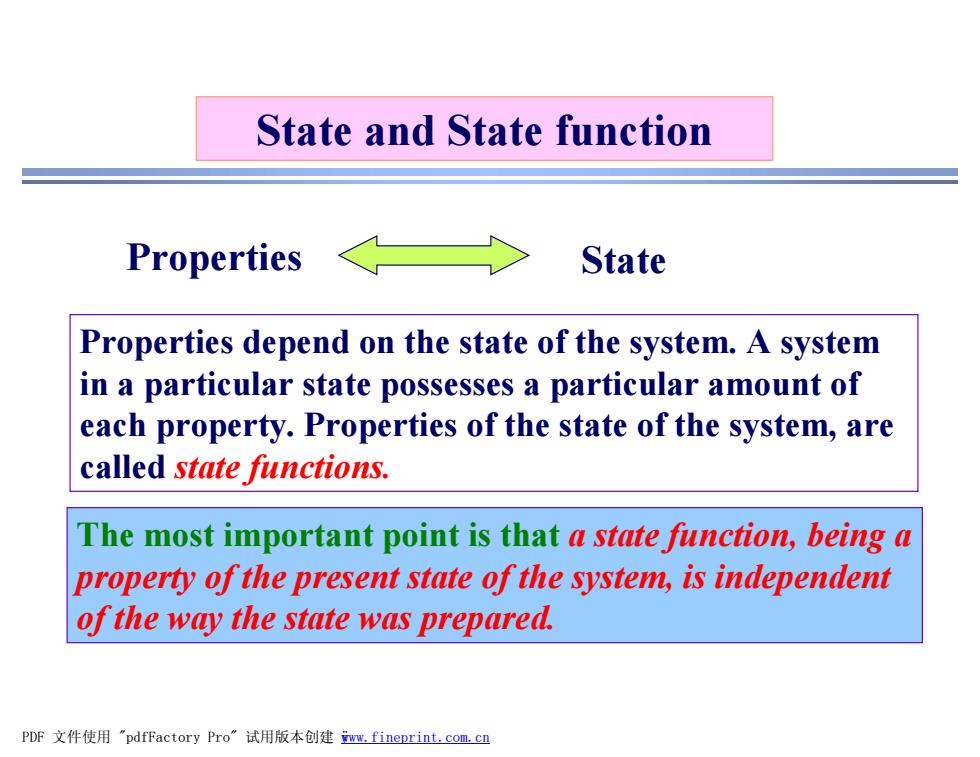
State and State function Properties State Properties depend on the state of the system.A system in a particular state possesses a particular amount of each property.Properties of the state of the system,are called state functions. The most important point is that a state function,being a property of the present state of the system,is independent of the way the state was prepared. PDF文件使用"pdfFactory Pro”试用版本创建m,fineprint.com,cn
State and State function Properties State Properties depend on the state of the system. A system in a particular state possesses a particular amount of each property. Properties of the state of the system, are called state functions. The most important point is that a state function, being a property of the present state of the system, is independent of the way the state was prepared. PDF 文件使用 "pdfFactory Pro" 试用版本创建 ÿwww.fineprint.com.cn
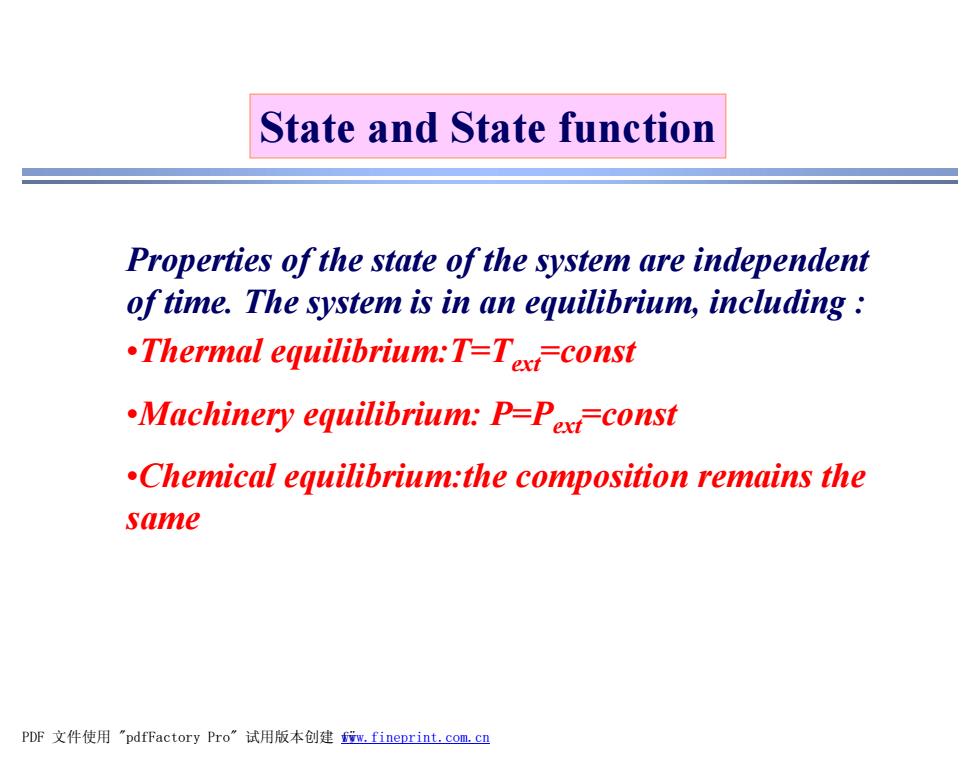
State and State function Properties of the state of the system are independent of time.The system is in an equilibrium,including Thermal equilibrium:T=Tex=const Machinery equilibrium:P=Pex=const Chemical equilibrium:the composition remains the same PDF文件使用"pdfFactory Pro”试用版本创建m,fineprint.com,cn
Properties of the state of the system are independent of time. The system is in an equilibrium, including : •Thermal equilibrium:T=Text =const •Machinery equilibrium: P=Pext =const •Chemical equilibrium:the composition remains the same State and State function PDF 文件使用 "pdfFactory Pro" 试用版本创建 f www.fineprint.com.cn ÿ
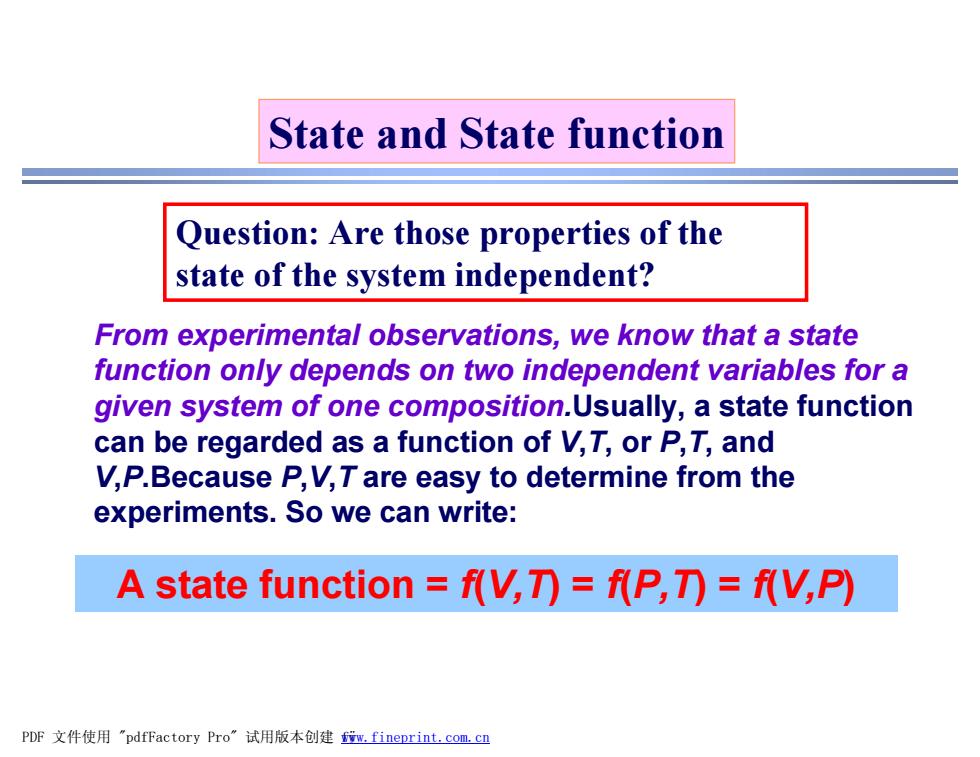
State and State function Question:Are those properties of the state of the system independent? From experimental observations,we know that a state function only depends on two independent variables for a given system of one composition.Usually,a state function can be regarded as a function of V,T,or P,T,and V,P.Because P,V,T are easy to determine from the experiments.So we can write: A state function =f(V,)=f(P,T)=f(V,P) PDF文件使用"pdfFactory Pro”试用版本创建m,fineprint.com,cn
From experimental observations, we know that a state function only depends on two independent variables for a given system of one composition.Usually, a state function can be regarded as a function of V,T, or P,T, and V,P.Because P,V,T are easy to determine from the experiments. So we can write: State and State function A state function = f(V,T) = f(P,T) = f(V,P) Question: Are those properties of the state of the system independent? PDF 文件使用 "pdfFactory Pro" 试用版本创建 f www.fineprint.com.cn ÿ